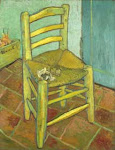
I was all set to blog today about the superb book "The Venus Fixers," until I read
this article in today's Times Online: a teaser piece about a forthcoming article in January's Art Newspaper by art critic and van Gogh enthusiast Martin Bailey. In 2005, a superbly researched article by Bailey in Apollo magazine argued that van Gogh may have learned about his brother Theo's engagement the morning of 23 December 1888 and that this news may have been the 'final straw' that led to Vincent's breakdown and self-mutilation that night. (I was so convinced by his theory that I used it in "Sunflowers." Merci, Mr. Bailey!) Bailey's forthcoming article produces additional evidence to support this theory, via a new reading of the one of the first paintings Vincent produced after leaving the hospital early in the new year. "Still Life with Onions" (click image to enlarge) from January 1889 has been seen as a "demonstration piece" (in the words of Douglas Druick and Peter Zegers, in their "Van Gogh and Gauguin: The Studio of the South" exhibition catalogue, p. 168) to prove Vincent's continued ability to paint and as a form of self-portrait, much like van Gogh had done in his famous Chair painting not long before. On the table we see onions (which Vincent in fact added in the background of his Chair painting), Vincent's pipe and tobacco pouch (also in the Chair painting), a lit candle (which appears in the Gauguin's Chair picture), a book about health, an empty bottle of wine, and a letter. (This painting makes a cameo appearance in "Sunflowers," by the way.)
Bailey's new article, of which the Times piece gives only a taste, evidently focuses on the letter depicted in the painting. The envelope is addressed to Vincent and must be from Theo. Bailey demonstrates that the "67" you see on the envelope indicates a post office in the Place des Abbesses, not far from where Theo lived. (Readers of "Sunflowers" know that by coincidence Rachel gains a connection to someplace in the Place des Abbesses late in the book. I can't help but giggle.) He also learned through his research that the special New Year's Day postmark seen on the envelope was placed on Paris mail from mid-December onward. Bailey argues that this letter in the painting is the very one Vincent received the morning of 23 December containing the news of Theo's marriage.
The Times article states, "It is known from a letter he [Vincent] wrote to Theo at the end of January 1889 that he had received what he called 'the much-needed money' on December 23." I scratched my head at this at first, because I didn't remember that detail from Bailey's 2005 article--because it's not there. Up until now, there's been no proof Vincent received a letter that day. That part of Bailey's original theory had to remain speculative. So I ran to my Brand New Shiny Set of Van Gogh Letters (I still need to do a proper review of this masterpiece set of books), and by golly, there IS a new piece of evidence, in the new translation of the letter Vincent sent Theo on 17 January 1889. A crucial difference in the new translation of one sentence in this letter versus the old translation we've all seen in English up until now. Clearly the Times article is leaving out this neato tidbit so as not to steal the fun from the Art Newspaper article, so I'm not going to give the game away either. But heehee hoho, Bailey's theory from 2005 seems poised to be right. Bravo!
I wait with eagerness for the full article...









